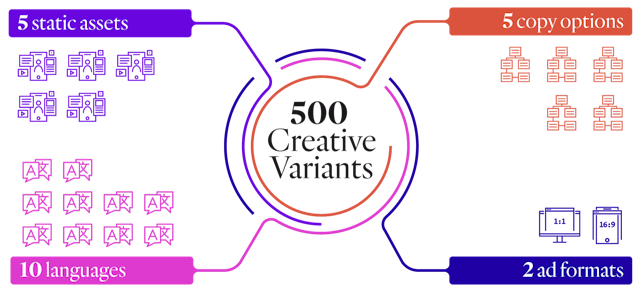Does creative automation mean the end for creative agencies?
In today’s always-on digital economy, marketers are looking to automated solutions to meet content demands. Does this spell the end of creative agencies? Amy Brooks and Joanna Verkade of Frog investigate.

What does the future of modular content creation mean for creative agencies? / Ryan Quintal via Unsplash
It’s becoming increasingly difficult for brands to deliver creative cut-through at scale while maintaining relevancy (and consistency) to match the pace of content consumption and ever-evolving consumer behavior. Add to this swelling time pressures impacting go-to-market (GTM), creative agencies inundated with administrative requests and (every marketer’s worst nightmare) dreaded budget cuts, and we have the perfect recipe for creative collapse.
The role of creative assets in campaign success is well documented, with some claiming it’s responsible for 70% of performance. And yet, with just 16% of advertising being recalled correctly, 56% of consumers deem creative assets irrelevant to their likes and interests; and 66% claim brand ads are repetitive. There’s a clear problem to solve.
Enter modular design and creative automation.
Advertisement
Modular-what?
Modular design is a digital creative system that operates based on a template subdivided into smaller component parts that can be independently created, modified, optimized or replaced. To build a modular template, raw design files are imported (typically from a DAM) into a creative automation platform, such as Celtra or Jivox. This is where the magic happens. Modular ‘master’ templates are built out within the tool. These can be shared with local teams or agencies to then adapt the assets into required variants according to predetermined criteria across an infinite number of digital channels via an API.
In short, modular design and creative automation – henceforth, collectively, ‘modular creative’ – enable brands to deliver optimized content at scale, at speed and through cost-efficient means. Imagine five static images, five copy options, translated into 10 languages with two ad formats: through automation you’d generate 500 creative variants, at a fraction of the cost and in the blink of an eye.

Modular creative allows for countless benefits, with many successful brands hopping on the innovation bandwagon.
Tui, for example, used modular creative to turn one video into over 100 different combinations of content to reach new customers through social. Using A/B testing to validate various hypotheses and by applying all the learnings mid-flight, they achieved 72% lower cost-per-initiate checkout and 36% cost-per-purchase. Modular creative drove campaign performance by delivering highly personalized assets at speed, and enabling multi-variant test-and-learn at scale.
A global sportswear brand built modular master templates using Celtra’s technology, which were cascaded to local markets to adapt into hundreds of localized variants, while also adhering to complex brand guidelines. This resulted in 60x reduced production effort and up to 425% more assets per market, enabling the brand to deliver greater creative consistency through centralized governance, while empowering local teams.
Finally, a global FMCG, in collaboration with Frog, worked to revolutionize their digital creative strategy across their brand portfolio to strengthen creative compliance, reduce creative wastage and boost campaign GTM. To date, they’ve scaled their creative output, producing digital assets an average of 3x faster and generating up to 73% cost savings per campaign v traditional creative.
Advertisement
Sounds like we no longer need our creative agency then?
Absolutely not.
Nine of out 10 marketers claim their creative teams need more time to devote to the creative process. Creative automation enables this. Adopting a modular way of thinking means creative agencies can devote more time to developing out-of-the-box creative ideas as opposed to editing a particular version of a display ad, keeping innovation at the heart of your creative strategy.
There’s a key role for in-house creative teams here. By ensuring designers are up-skilled and tech-led, the creative team of the future can drive the localization of global master templates, ready for campaign launch while ensuring compliance to complex brand guidelines throughout.
So, whether your brand uses a creative agency to define your strategy, in-house designers for asset localization, or a combination of the two, modular design and creative automation enable efficiencies you never thought possible.
Suggested newsletters for you
Is modular design right for my brand?
To keep up with digital demand, placing content localization, agility, personalization and performance measurement at the center of your creative approach is the recipe for success.
Therefore, if your brand is experiencing cost or time pressures, or asset or market complexities, take this as a sign to act now.
If you’re curious to hear more about our offers at Frog, whether modular creative is right for your brand, or how we can help integrate it into your operational model and drive sustained change to your business, get in touch.
Amy Brooks and Joanna Verkade are consultants at Frog (part of Capgemini Invent).
Content by The Drum Network member:

frog
frog is a leading global creative consultancy, part of Capgemini Invent. Partnering with passionate leaders and visionary entrepreneurs, we apply creativity, strategy,...
Find out more
